Exploring the Best Hidden Beaches of the Dominican Republic
Introduction to the Hidden Gems of the Dominican Republic
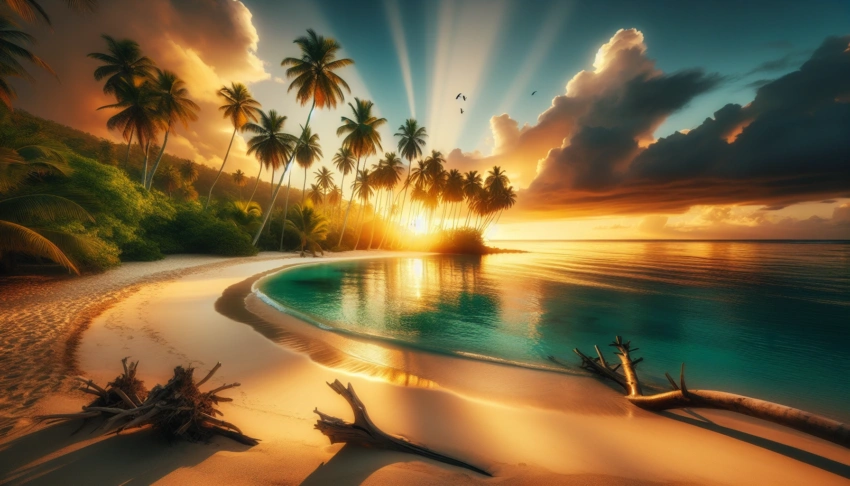
Exploring the Best Hidden Beaches of the Dominican Republic
Imagine strolling along pristine sands where your footprints are the only ones for miles. The Dominican Republic, a paradise known for its bustling resorts and vivid nightlife, also harbors some of the most breathtaking hidden beaches in the Caribbean. These secluded gems offer solitude and serenity amidst nature’s untouched beauty, providing a perfect escape from the chaos of everyday life.
1. Why Explore Hidden Beaches?
In a world where we’re constantly surrounded by noise and crowds, finding a slice of paradise untouched by mass tourism can be a transformative experience. Hidden beaches not only allow you to unwind and reconnect with nature but also offer a sense of adventure and exploration. Unlike their popular counterparts, these secluded spots provide an opportunity to enjoy the beauty of the ocean in a more intimate setting.
Visiting these beaches can often lead to unique discoveries, such as finding rare sea shells, spotting exotic wildlife, or even witnessing a stunning sunset framed by untouched landscapes. They also tend to be cleaner and more preserved, offering crystal-clear waters and vibrant marine life just waiting to be explored. By choosing the road less traveled, you contribute to sustainable tourism and help preserve these natural wonders for future generations.
2. Overview of the Dominican Republic’s Coastal Beauty
The Dominican Republic boasts over 800 miles of coastline, each stretch more captivating than the last. From the rugged cliffs of the northern coast to the sprawling white sands of the south, the island’s beaches are as diverse as they are beautiful. The Caribbean Sea and the Atlantic Ocean provide contrasting experiences; the Caribbean side is known for its calm, turquoise waters, while the Atlantic offers dramatic waves and spectacular sunsets.
The country’s geographical diversity is what makes its coastal beauty so unique. Imagine towering palm trees swaying in the gentle breeze, lush mountains that seem to rise out of the ocean, and coral reefs teeming with life just below the surface. This vibrant tapestry of landscapes ensures there’s a hidden beach to suit every preference, whether you’re seeking solitude, adventure, or a little bit of both.
3. How to Find These Secluded Spots
Embarking on a quest to uncover the Dominican Republic’s hidden beaches requires a bit of planning and adventure spirit. Start by researching less-known regions of the island, such as the Samana Peninsula or the southwestern coast near Pedernales. These areas are often less developed and offer a more authentic experience away from the tourist hotspots.
Consider renting a car to give yourself the freedom to explore off-the-beaten-path locations. Local guides can also be invaluable, offering insider knowledge about the best secret spots and how to access them safely. Don’t be afraid to ask locals for recommendations; they often know the most beautiful hidden gems that aren’t listed in guidebooks.
Navigating through the lush landscapes to reach these secluded beaches can be an adventure in itself. Trails might lead you through tropical forests or along cliffside paths, each step revealing more of the island’s stunning natural beauty. Ensure you have a reliable map or GPS, and always check the weather to avoid surprises on your journey.
In summary, the Dominican Republic’s hidden beaches offer an unparalleled opportunity to connect with nature and experience the island’s authentic beauty. By venturing off the beaten path, you’ll not only find tranquility and adventure but also contribute to preserving these precious environments.
Top Hidden Beaches You Must Visit
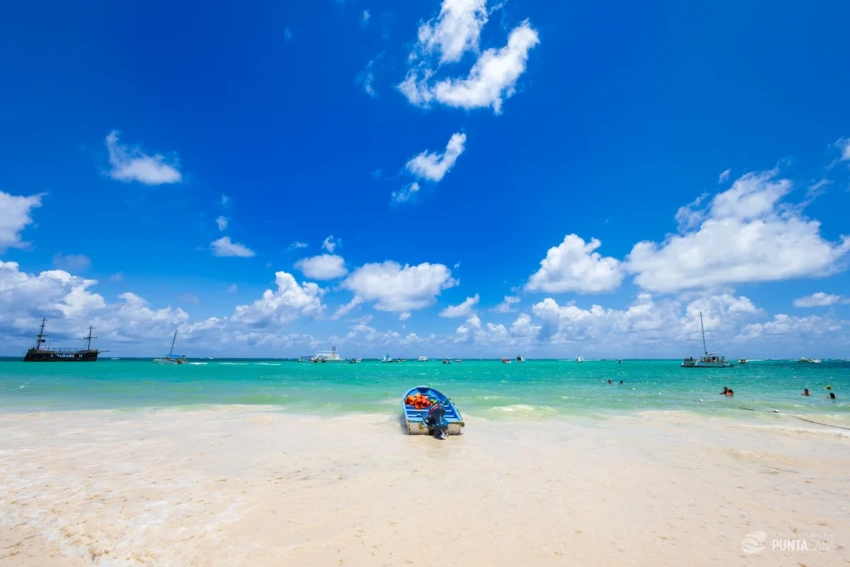
Punta Cana
The Dominican Republic is dotted with hidden beaches that promise serenity, pristine sands, and untouched natural beauty. These secluded spots offer a perfect escape from the bustling tourist traps.
1. Playa Rincón: A Secluded Paradise
Nestled away on the Samaná Peninsula, Playa Rincón is a gem of the Caribbean. This beach is often ranked among the most beautiful in the world, thanks to its crystal-clear waters and powdery white sand. What truly makes Playa Rincón special is its untouched environment, as it remains one of the few beaches that hasn’t been overrun by commercial development.
Playa Rincón stretches over three miles and is flanked by lush palm trees and dramatic cliffs, creating a postcard-perfect landscape. Visitors can enjoy a leisurely swim in the calm waters or take a stroll along the shore collecting seashells. For those seeking a bit more adventure, the nearby Caño Frío river offers a refreshing swim where the fresh water meets the ocean.
Getting to Playa Rincón requires some effort, often involving a scenic drive or a boat ride from Las Galeras, but the journey is part of the adventure and is well worth the trip.
2. Bahía de las Águilas: A Remote Oasis
Bahía de las Águilas, located in the southwestern part of the country, is a remote oasis known for its otherworldly beauty. This eight-kilometer stretch of beach is part of the Jaragua National Park and is a protected area, ensuring its pristine condition. The beach is celebrated for its turquoise waters and diverse marine life, making it a haven for snorkeling enthusiasts.
Access to Bahía de las Águilas requires a bit of planning. It’s typically reached via a boat from the nearby village of La Cueva or by an off-road vehicle. This isolation adds to its charm, providing visitors with a sense of discovery and exclusivity.
The surrounding area is sparse in terms of facilities, so visitors should come prepared with supplies. However, the lack of development also means uninterrupted vistas of stunning natural beauty—an unforgettable experience for any beach lover.
Our Best Tours in Punta Cana
For those eager to explore these hidden gems, our curated tours offer a seamless way to experience the untouched beauty of these beaches. With expert guides and convenient transportation, you can focus on soaking up the sun and scenery without any hassle.
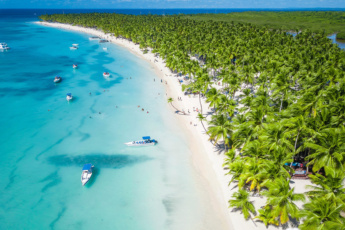
Saona Island Excursion - Caribbean Paradise
from $75 Read more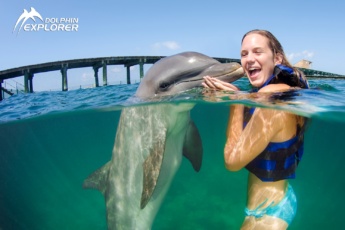
Swimming with Dolphins in Punta Cana - Top Adventure 2026 (50 minutes)
from $155 Read more3. Playa Frontón: Adventure and Relaxation Combined
Tucked away near the town of Las Galeras, Playa Frontón is a hidden treasure that offers a perfect blend of adventure and relaxation. This secluded beach is accessible only by hiking or by boat, making it an ideal destination for those seeking an off-the-beaten-path experience.
The beach is framed by towering cliffs, providing a dramatic backdrop that is perfect for photography enthusiasts. The waters here are teeming with vibrant marine life, offering excellent opportunities for snorkeling. Adventurers can also try their hand at rock climbing on the cliffs that surround the beach.
Despite its remote location, Playa Frontón has a rich ecosystem that is worth exploring. The journey to this hidden paradise is an adventure in itself, rewarding travelers with a tranquil and breathtaking environment that feels like a private escape.
Activities to Enjoy on Hidden Beaches
The hidden beaches of the Dominican Republic are not just about serene landscapes and tranquil settings. They offer a plethora of activities that can transform a simple day by the sea into an unforgettable adventure. Whether you’re a thrill-seeker or someone who enjoys the quieter pleasures, there’s something for everyone to enjoy.
1. Snorkeling and Marine Life Exploration
The crystal-clear waters surrounding the Dominican Republic’s hidden beaches are a haven for snorkeling enthusiasts. These secluded spots often boast vibrant coral reefs teeming with an array of marine life. You can expect to encounter colorful fish, graceful sea turtles, and perhaps even a friendly stingray or two.
For the ultimate snorkeling experience, consider visiting during the morning hours when the waters are typically calmer, providing better visibility. Some of the best hidden beaches for snorkeling include Playa Rincón and Bahía de las Águilas, where the aquatic ecosystems remain largely undisturbed by human activity.
- Bring your own snorkeling gear to ensure a comfortable fit and to avoid the need to rent equipment, which might not be available at these remote locations.
- Look for areas with rocky formations or coral patches, as these are typically hotspots for marine life.
2. Beachcombing and Shell Collecting
Hidden beaches are often treasure troves for beachcombers, offering a wide variety of shells and unique sea glass. The gentle waves and untouched sands make these spots perfect for leisurely strolls, where you can uncover nature’s little gems.
For the best finds, visit early in the morning or during low tide when the sea has freshly deposited its bounty on the shore. Remember to collect responsibly, taking only a few select pieces and leaving enough for the ecosystem to thrive.
- Pack a small bag or container to store your finds and protect them from breaking.
- Research the local regulations regarding shell collecting, as some areas may have restrictions to preserve the natural habitat.
3. Photography: Capturing the Untouched Beauty
With their breathtaking landscapes and pristine settings, these hidden beaches are a photographer’s dream. Whether you’re a professional or an amateur, capturing the untouched beauty of these places can be incredibly rewarding. The play of light on the water, the vibrant colors of the sky during sunset, and the diverse flora and fauna provide endless opportunities for stunning shots.
For the best results, visit during the golden hours—shortly after sunrise or before sunset—when the lighting is soft and warm. Don’t forget to explore different angles and perspectives; sometimes the most unexpected shots turn out to be the most captivating.
- Consider bringing a tripod for stability, especially if you’re aiming to capture long-exposure shots of the waves.
- Experiment with your camera settings to capture the vibrant colors and contrasts that these beaches offer.
Remember, while enjoying these activities, it’s crucial to respect the natural environment to ensure that these hidden gems remain pristine for future visitors. Leave no trace, take only pictures, and leave only footprints.
Local Culture and Cuisine Near Hidden Beaches
When exploring the hidden beaches of the Dominican Republic, don’t miss the opportunity to delve into the vibrant local culture and savor the unique culinary delights that the region offers. This section will guide you through an unforgettable cultural and gastronomic journey.
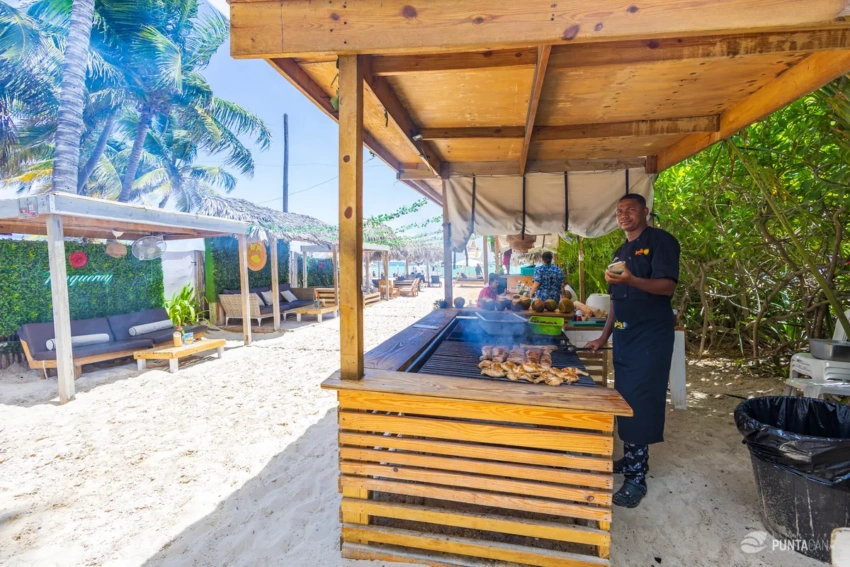
Punta Cana
1. Traditional Dominican Dishes to Try
The Dominican Republic is a melting pot of flavors, and its cuisine is a testament to the island’s rich cultural history. When you’re near hidden beaches, it’s the perfect time to sample some of the local dishes that make Dominican food so special. Mofongo, a dish made from mashed plantains seasoned with garlic and pork cracklings, is a must-try for anyone looking to experience authentic Dominican flavors. Pair it with a side of arroz con habichuelas (rice and beans) for a true taste of the island.
For seafood lovers, pescado frito (fried fish) fresh from the local catch provides a simple yet delicious meal, often served with a squeeze of lime and a side of tostones (fried green plantains). Don’t forget to try the refreshing morir soñando, a creamy orange juice and milk drink that is both a beverage and a dessert.
2. Cultural Events and Festivals
The Dominican Republic is renowned for its lively cultural scene, and even the most secluded beaches are often just a stone’s throw away from a festive celebration. Participate in the Carnaval, held in February, where vibrant parades and colorful costumes fill the streets, showcasing the island’s African, Taíno, and Spanish heritage. If you’re visiting during Holy Week, experience the unique blend of religious processions and joyous gatherings that offer insight into the local customs.
Music is at the heart of Dominican culture, and a trip to the beach is incomplete without catching a bachata or merengue performance. These electrifying genres are sure to get you moving and provide a window into the island’s soul.
3. Interacting with Local Communities
Engaging with local communities can greatly enhance your travel experience, offering a more profound understanding of the Dominican way of life. Here are some tips to ensure your interactions are respectful and enriching.
Firstly, learning a few basic phrases in Spanish can go a long way in connecting with locals. A friendly “Hola” or “Gracias” can open doors to warm interactions and genuine smiles. Be mindful of cultural norms, such as greeting people with a handshake or a kiss on the cheek, depending on the situation.
Participating in community activities, such as local markets or cooperative tours, supports sustainable tourism and provides insights into daily life. Purchasing handmade crafts or attending a local cooking class not only contributes to the economy but also allows you to take a piece of the Dominican culture home with you.
Our Curated Experiences Near Hidden Beaches
Discover exclusive tours that immerse you in the vibrant culture and cuisine of the Dominican Republic. From cooking classes with local chefs to guided tours of cultural festivals, these experiences are crafted to enrich your journey.
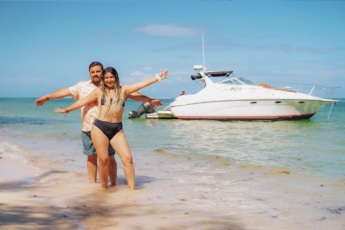
Punta Cana Private Boat Trip at the Best Price - 3-Hour Exclusive Tour with Snorkeling (from Jellyfish to Cabeza de Toro)
from $590 Read more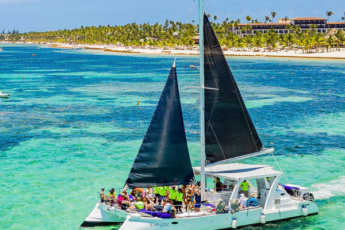
Power Cruise – Punta Cana Party Experience on the Bad Girl Catamaran
from $65 Read morePractical Tips for Visiting Hidden Beaches
Embarking on a journey to discover the lesser-known beaches of the Dominican Republic promises an adventure filled with tranquility and awe-inspiring natural beauty. However, to truly relish the experience, it’s vital to prepare adequately and responsibly. Dive into our practical tips to ensure your visit is both safe and unforgettable.
1. Best Time to Visit for Optimal Experience
Understanding when to visit is crucial for maximizing your beach escapade. The Dominican Republic’s climate is generally tropical, with variations between the wet and dry seasons.
Dry Season (December to April): This period is considered the best time to visit. The weather is pleasantly warm with minimal rainfall, making it ideal for beach activities like sunbathing, snorkeling, and exploring.
Wet Season (May to November): While there’s a higher chance of rain, this season also offers benefits. The landscapes are lush and vibrant, and there are fewer tourists, granting a more secluded experience. If you don’t mind the occasional shower, the wet season can be a rewarding time to explore.
2. Packing Essentials for a Day at a Hidden Beach
To ensure your outing is comfortable and stress-free, it’s essential to pack smartly. Here’s a handy checklist to guide you:
- Sun Protection: Sunscreen with a high SPF, sunglasses, and a wide-brimmed hat are non-negotiables to protect against the tropical sun.
- Hydration and Snacks: Carry plenty of water and light snacks. Hidden beaches often lack nearby amenities.
- Beach Gear: A lightweight beach towel, snorkeling gear, and waterproof bags for your electronics.
- First Aid Kit: Basic supplies like band-aids, antiseptic wipes, and insect repellent can be handy.
- Navigation Tools: A map or GPS device to help you navigate uncharted paths.
3. Safety Precautions and Environmental Responsibility
Your adventure to hidden beaches doesn’t only have to be about relaxation and fun; it’s also about ensuring safety and preserving the environment.
Safety Tips:
– Always inform someone about your travel plans and expected return time.
– Be mindful of the tides and currents, especially if you’re planning on swimming or snorkeling.
– Keep an eye out for wildlife and maintain a respectful distance.
Environmental Responsibility:
– Leave No Trace: Carry back all your trash and dispose of it properly.
– Avoid disturbing the natural habitat. This includes not picking plants or disturbing wildlife.
– Use reef-safe sunscreen to protect marine life.
Equipped with these practical tips, you’re now ready to dive into the hidden treasures of the Dominican Republic’s beaches, savoring each moment with a sense of adventure and respect for nature. Let the waves guide you to serenity and unforgettable memories.
Frequently Asked Questions
What are some of the best hidden beaches to visit in the Dominican Republic?
The Dominican Republic boasts several stunning hidden beaches worth exploring. Some of the top choices include Playa Rincón in Samaná, known for its pristine white sand and crystal-clear waters; Playa Frontón, which is accessible only by boat or a hike and features dramatic cliffs; and Bahía de las Águilas in the Pedernales region, renowned for its untouched beauty.
How can I reach these hidden beaches?
Access to hidden beaches in the Dominican Republic can vary.
- Playa Rincón is accessible by car, followed by a short walk.
- Playa Frontón requires a boat ride or a guided hike through lush trails.
- Bahía de las Águilas is best reached by boat from nearby Cabo Rojo or by a four-wheel-drive vehicle.
It’s advisable to plan ahead and check local conditions.
Are these hidden beaches safe for swimming?
Generally, the waters at these hidden beaches are safe for swimming, but it’s crucial to be cautious.
Always check local weather conditions and tidal patterns before swimming, and be aware that there might not be lifeguards on duty.
What should I pack when visiting these hidden beaches?
When visiting hidden beaches, pack essentials like sunscreen, a hat, plenty of water, snacks, a towel, and snorkeling gear if you’re interested in exploring underwater.
Consider bringing a first-aid kit and ensure you have a reliable way to communicate, like a fully charged phone.
Can I camp overnight on these hidden beaches?
Camping policies vary by location. Bahía de las Águilas is part of a national park, and overnight camping may be restricted. It’s best to confirm with local authorities or guides if camping is allowed and what permits might be needed.
Are there any nearby accommodations if I don't want to camp?
Yes, there are accommodations near most hidden beaches. For example, near Playa Rincón, you can find lodges and small hotels in Las Galeras. Close to Bahía de las Águilas, options are available in Pedernales and Cabo Rojo. It’s advisable to book in advance, especially during peak travel seasons.
What is the best time of year to visit these hidden beaches?
The ideal time to visit the Dominican Republic’s hidden beaches is during the dry season, from December to April. This period offers more predictable weather and less rainfall, enhancing your beach experience.
Are there any environmental considerations I should be aware of when visiting these beaches?
Yes, it’s important to respect the natural environment.
Avoid leaving trash, disturb wildlife, or damage vegetation. Use reef-safe sunscreen to protect marine life.
Following these guidelines helps preserve the beauty and ecological balance of these pristine locations.
